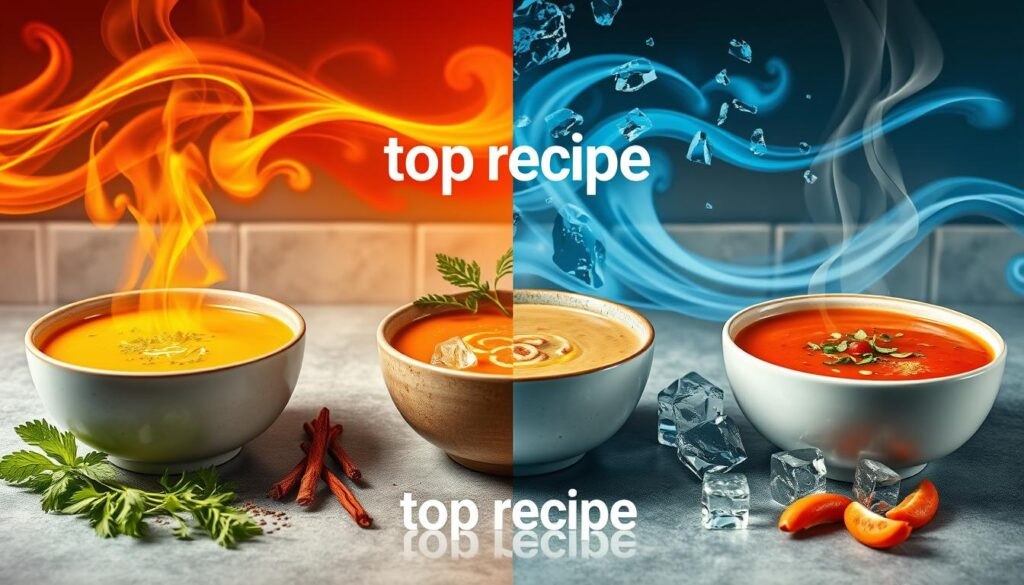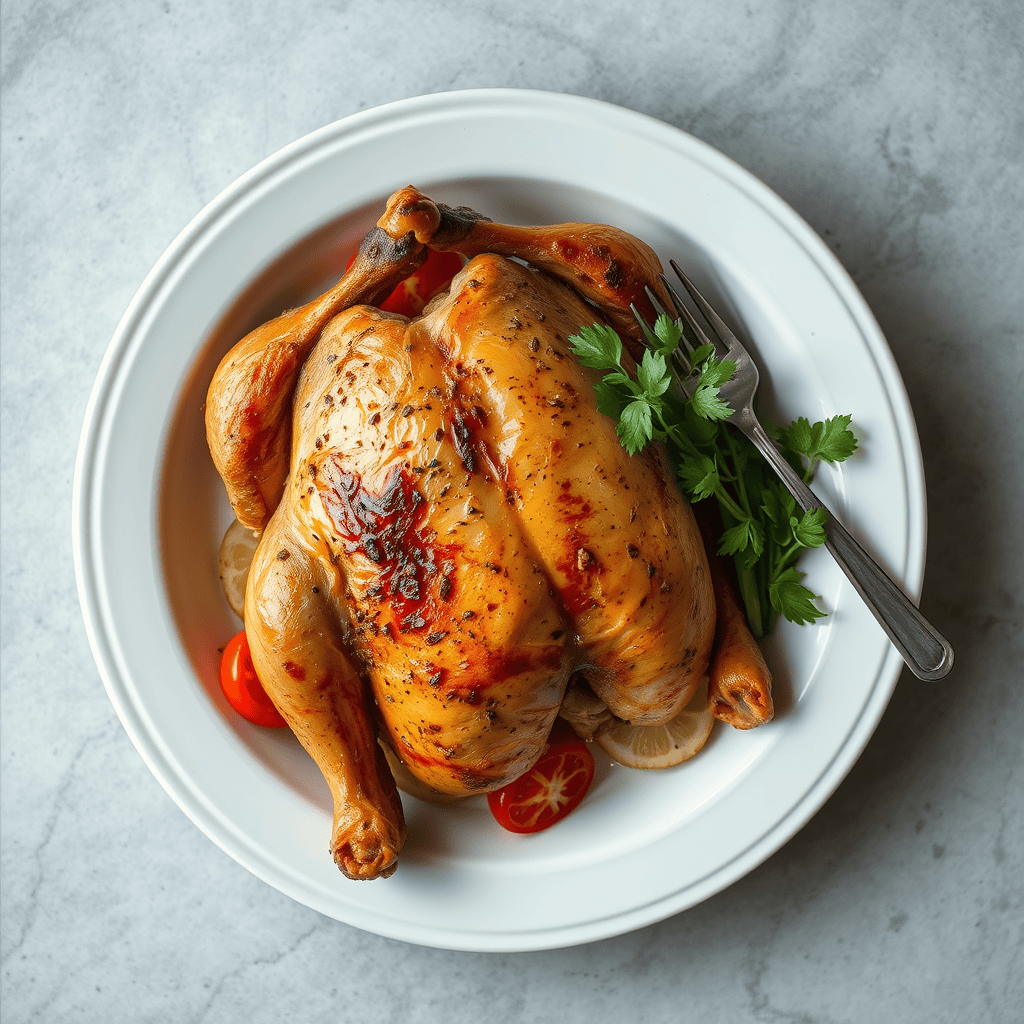In the world of cooking, abiotic factors in soup recipes are very interesting. Chefs and food lovers find them fascinating. These factors, like temperature and acidity, affect the taste, texture, and health of soups.
This article explores the world of abiotic factors. It gives tips for both home cooks and professional chefs. These tips can help make soups even better.

Key Takeaways
- Abiotic factors, such as temperature, acidity, and pressure, significantly influence the flavor, texture, and nutritional value of soups.
- Understanding the impact of these environmental elements can help cooks create more delicious and healthier soup dishes.
- Techniques like temperature control, acidity balancing, and pressure cooking can be leveraged to optimize soup recipes.
- Harnessing the power of abiotic factors can lead to improved soup textures and enhanced nutrient preservation.
- Exploring the science behind abiotic factors in soup preparation can inspire culinary innovation and elevate the soup-making experience.
Exploring the Role of Abiotic Factors in Soup Recipes
Soup recipes are a culinary delight that can be elevated by understanding the impact of abiotic factors. These non-living components, such as temperature, acidity, and pressure, play a crucial role in shaping the flavor, texture, and nutritional profile of soups. By exploring the fascinating world of abiotic factors in soup recipes, home cooks and professional chefs alike can unlock a new level of culinary mastery.
Understanding Abiotic Factors
Abiotic factors are the non-living elements of an environment that influence the growth, development, and behavior of living organisms. In the realm of soup recipes, these factors can have a profound impact on the final product. From temperature fluctuations that affect the extraction of flavors to the pH levels that impact the balance of acidity, each abiotic factor presents an opportunity to fine-tune the culinary experience.
Incorporating Abiotic Factors in Cooking
The strategic incorporation of abiotic factors can elevate soup recipes to new heights. By understanding the role of temperature in extracting and developing flavors, chefs can create soups with depth and complexity. Similarly, by manipulating the acidity levels, they can enhance the overall taste and balance of the dish. Additionally, the use of pressure cooking techniques can unlock new flavor profiles and improve the efficiency of the cooking process.
Embracing the influence of abiotic factors in soup recipes, home cooks and professional chefs alike can unlock a world of culinary possibilities. From mastering the art of temperature control to harnessing the power of acidity, the exploration of these non-living elements can lead to the creation of truly exceptional soups that delight the senses and nourish the body.
“Embracing the influence of abiotic factors is the key to unlocking the full potential of soup recipes.”
The Impact of Temperature on Soup Flavors
Cooking temperature is key to changing soup flavors. Knowing how temperature affects taste and aroma opens up new flavor possibilities.
Higher temperatures make flavors stronger and more intense. Lower temperatures make them softer and more subtle. For instance, high heat can make vegetables sweeter. Low heat keeps herbal flavors delicate.
Let’s look at tomato soup as an example. Simmering it at high heat brings out the tomato’s rich flavor and sweetness. Cooking it at low heat makes the tomatoes taste fresher and more acidic.
“The temperature of your soup pot can be the difference between a deep, complex flavor and a one-note dish. Mastering the art of temperature control is key to unlocking the full potential of your ingredients.”
Adjusting temperature lets you create different flavors. You can make soups that are hearty or light, depending on your taste. Understanding temperature impact on soup flavor is important in cooking.

Pay attention to how ingredients react to temperature. With some trial and error, you can make soups that are delicious and show off your cooking skills.
Harnessing the Power of Acidity in Soup Preparation
Mastering soup-making is all about finding the right balance of flavors. Acidity is key in this balance. It affects taste, texture, and nutrition. By understanding acidity, cooks can make their soups better.
Balancing Acidity for Optimal Taste
Getting the acidity right in a soup is crucial for a great taste. Too much makes it too tart, too little makes it bland. The goal is to find the perfect balance.
Try using different acidic ingredients like lemon juice, vinegar, or tomatoes. Adjusting these can fine-tune the soup’s acidity. This makes the soup taste better to you.
Adding alkaline ingredients like dairy, herbs, or baking soda can also help. They balance out the acidity. This balance is a key part of cooking.
| Acidic Ingredients | Alkaline Ingredients |
|---|---|
| Lemon juice, lime juice, vinegar, tomatoes, wine | Dairy products, herbs, baking soda |
Learning to balance acidity in soup preparation opens up new flavors. It makes soups more enjoyable to eat.
“The secret to a truly exceptional soup lies in the perfect marriage of flavors, where acidity plays a starring role.”

Soup Recipes: Abiotic Factor
In the world of cooking, knowing about abiotic factors is key for making great soups. These factors, like temperature, acidity, and pressure, affect how soups taste, feel, and what nutrients they have. Let’s see how you can use these factors to make your soups better.
Harnessing Temperature for Vibrant Flavors
Temperature is crucial for bringing out flavors in soups. By controlling the cooking temperature, you can release more aromatic compounds. This makes your soups taste better. Try simmering, boiling, and pressure cooking to see how temperature changes your soup’s flavor.
Balancing Acidity for Optimal Taste
Acidity also plays a big role in soup taste. The right amount of acidity makes flavors pop, but too much or too little can mess it up. Adding tomatoes, citrus, vinegar, or wine can help get the acidity just right. This creates a balanced flavor in your soup.
Leveraging Pressure for Richer Broths
Pressure cooking can make your soup broths richer. It extracts more nutrients and concentrates flavors. This results in a broth that’s deeper and more complex, making your soups even better.
Mastering abiotic factors is the secret to making amazing soups. By playing with temperature, acidity, and pressure, you can explore new flavors. This way, your soups will not only be good for you but also a treat for your taste buds.

| Abiotic Factor | Impact on Soup Recipes | Recommended Techniques |
|---|---|---|
| Temperature | Influences flavor extraction and development | Simmering Boiling Pressure cooking |
| Acidity | Balances flavors and enhances taste | Incorporating acidic ingredients (e.g., tomatoes, citrus, vinegar) Adjusting pH levels |
| Pressure | Intensifies flavor and nutrient extraction in broths | Pressure cooking techniques |
“Understanding the interplay of abiotic factors is the key to crafting exceptional soup recipes that captivate the senses.”
By using abiotic factors, you can make soups that are not just healthy but also delicious. Try different temperatures, acidity levels, and pressures. Let your creativity shine in your soup recipes.
Elevating Soup Textures with Abiotic Factors
In the world of cooking, abiotic factors are key to changing soup textures. Temperature and acidity are just a few of these factors. They can make your soup experience better. Learning about these factors can help you make the perfect soup.
Incorporating Texture-Enhancing Agents
Adding texture-enhancing agents is a great way to improve your soup’s texture. These ingredients can thicken, smooth, or add creaminess. Some popular ones include:
- Starches: Cornstarch, arrowroot, and tapioca are all excellent choices for thickening soups and creating a silky-smooth texture.
- Dairy products: Cream, milk, and yogurt can add a rich, velvety mouthfeel to your soup.
- Pureed vegetables: Blending cooked vegetables into the soup can help to create a luxurious, creamy texture.
- Nut butters: Stirring in a spoonful of nut butter, such as peanut or almond butter, can lend a thick, creamy consistency to your soup.
Using these agents can make your soup more indulgent and satisfying.
| Texture-Enhancing Agent | Effect on Soup Texture | Examples |
|---|---|---|
| Starches | Thickening, Smooth | Cornstarch, Arrowroot, Tapioca |
| Dairy Products | Creamy, Velvety | Cream, Milk, Yogurt |
| Pureed Vegetables | Luxurious, Creamy | Blended Potatoes, Carrots, Squash |
| Nut Butters | Thick, Creamy | Peanut Butter, Almond Butter |
By using abiotic factors and adding texture-enhancing agents, you can make amazing soups. These soups will delight your guests and make them want more.
Preserving Nutrients in Soups: Abiotic Factors at Play
In the world of cooking, keeping soups nutritious is key. Things like temperature and pressure are important. They help keep the good stuff in the ingredients. Chefs can make their soups even better by knowing how these factors work.
Temperature is very important for keeping nutrients in soups. Too hot can ruin some vitamins and minerals. But, cooking at a lower temperature helps keep more nutrients in.
Pressure also plays a big role. Using a pressure cooker, like an Instant Pot, helps keep nutrients in. It cooks food faster and keeps it from losing water-soluble vitamins.
| Abiotic Factor | Impact on Nutrient Preservation | Best Practices |
|---|---|---|
| Temperature | High temperatures can degrade heat-sensitive vitamins and minerals, while low temperatures help retain nutritional content. | Carefully control cooking temperature and simmering time to preserve nutrients. |
| Pressure | Pressure cooking can help lock in nutrients by reducing cooking times and minimizing exposure to oxygen. | Utilize pressure cooking methods, such as an Instant Pot or traditional pressure cooker, to maximize nutrient retention. |
Understanding how temperature and pressure affect soups is crucial. Chefs can make soups that taste great and are good for you. By following these tips, anyone can make their soups even better.
“The true chef recognizes that the finest ingredients are not enough; it is the preservation of their essential qualities that truly matters.”
The Influence of Pressure on Soup Cooking
Pressure is key in making soups. It affects the taste, texture, and nutrients. By changing the pressure, chefs can make soups with unique flavors.
Exploring Pressure Cooking Techniques
Pressure cooking helps get the most flavor from ingredients. It raises the boiling point, making cooking faster and more effective. This way, more nutrients and aromas are extracted.
It’s great for tough ingredients like root veggies, legumes, or meat. The high pressure makes them tender and blends them well with the soup. This creates a balanced and rich taste.
| Pressure Cooking Technique | Ideal Ingredients | Cooking Time Reduction |
|---|---|---|
| High-Pressure Cooking | Root vegetables, legumes, tough meats | Up to 70% reduction |
| Low-Pressure Cooking | Delicate vegetables, seafood, dairy-based soups | 30-50% reduction |
Knowing how pressure affects soup cooking opens up new possibilities. Chefs can try different techniques to create exciting and tasty soups.
Maximizing Flavor with Abiotic Factors in Soup Broths
Creating delicious soups starts with the broth. Factors like temperature, acidity, and pressure are key. They help bring out the flavors that make a soup stand out. By using these elements, anyone can make a soup that everyone will love.
Temperature is important when making broth. Cooking bones, veggies, and herbs slowly releases oils and minerals. This creates a rich flavor. The right temperature also balances the taste, making it sweeter.
Acidity is another big factor. Adding acidic ingredients like vinegar or tomatoes balances the broth’s richness. This makes the soup refreshing and well-rounded. Finding the right balance is key to a great taste.
Pressure also affects the broth’s flavor and texture. Techniques like pressure cooking break down tough tissues. This makes the broth smooth and flavorful, enhancing the soup.
Understanding these factors lets cooks create amazing soups. Whether it’s a simple chicken noodle or a complex bone broth, the right use of temperature, acidity, and pressure matters. It’s all about making a memorable meal.
The Science of Abiotic Factors in Soup Thickening
Making your soup just right is an art that needs a good grasp of science. Things like temperature, acidity, and pressure are key. They help shape the soup’s texture and how it feels in your mouth.
Thickening agents are crucial in soup thickening. Starches like cornstarch or flour add a creamy feel. They turn into a gel when heated with liquid. By adjusting the heat and liquid, you can get the soup just right.
Acidity also plays a big role. The pH of your broth can change how thickening agents work. A higher acidity can make the soup feel velvety. Playing with acidic ingredients like tomatoes or vinegar can help you get the perfect consistency.
FAQ
What are abiotic factors and how do they impact soup recipes?
Abiotic factors are non-living parts of our environment that affect soup recipes. They include things like temperature, acidity, and pressure. These factors can change how soups taste, feel, and are good for us.
How can temperature affect the flavors of soup?
The cooking temperature can really change how soups taste. By adjusting the temperature, cooks can make soups taste different. This lets them create soups that everyone will enjoy.
What is the importance of balancing acidity in soup preparation?
Getting the acidity right is key for great-tasting soups. Cooks must balance the acidity to avoid soups that are too sour or too bland. This makes the flavors work well together.
How can abiotic factors be used to enhance the texture of soups?
Temperature and pressure can help change the texture of soups. By using these factors, cooks can make soups feel just right in your mouth. This makes the soup more enjoyable to eat.
How do abiotic factors impact the preservation of nutrients in soups?
Temperature and pressure are important for keeping nutrients in soups. Cooks can use these factors to keep soups healthy. This way, they can make soups that are good for you.
What is the influence of pressure on soup cooking?
Changing the pressure while cooking can greatly affect soups. Pressure cooking can make soups taste better, feel creamier, and keep more nutrients. This makes soups even more delicious.
How can abiotic factors be used to maximize the flavor of soup broths?
Broths are the base of many soups, and abiotic factors can make them better. By controlling temperature and acidity, cooks can make broths rich and tasty. This makes soups even more enjoyable.




